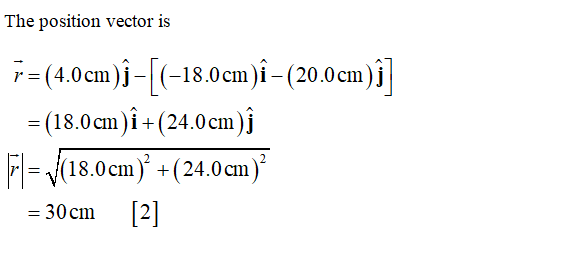Problem 15: A point charge, Q, of –75nC is affixed to the y-axis at yo electron is placed at some point P = (xp,Yp) in the x-y-plane, free to move subject to the electric field generated by Q. Assuming xp = -18.0cm and yp = -20.0cm, what is the electron's acceleration vector d = (a2, ay ), at point P? 4.0cm. An (A) (-0.79, –1.05) × 1015 m/s² (B) (+0.79, +1.05) × 1015 m/s² (C) (-1.05, –0.79) × 1015 m/s² (D) (+4.94, +6.59) × 1033 m/s² (E) {-7.20, –9.60) × 10-16 °m/s²
Problem 15: A point charge, Q, of –75nC is affixed to the y-axis at yo electron is placed at some point P = (xp,Yp) in the x-y-plane, free to move subject to the electric field generated by Q. Assuming xp = -18.0cm and yp = -20.0cm, what is the electron's acceleration vector d = (a2, ay ), at point P? 4.0cm. An (A) (-0.79, –1.05) × 1015 m/s² (B) (+0.79, +1.05) × 1015 m/s² (C) (-1.05, –0.79) × 1015 m/s² (D) (+4.94, +6.59) × 1033 m/s² (E) {-7.20, –9.60) × 10-16 °m/s²
Related questions
Question

Transcribed Image Text:Problem 15: A point charge, Q, of –75nC is affixed to the y-axis at yo
electron is placed at some point P = (xp,Yp) in the x-y-plane, free to move subject to the
electric field generated by Q. Assuming xp = -18.0cm and yp = -20.0cm, what is the
electron's acceleration vector d = (a2, ay ), at point P?
4.0cm. An
(A) (-0.79, –1.05) × 1015 m/s²
(B) (+0.79, +1.05) × 1015 m/s²
(C) (-1.05, –0.79) × 1015 m/s²
(D) (+4.94, +6.59) × 1033 m/s²
(E) {-7.20, –9.60) × 10-16
°m/s²
Expert Solution
Step 1

Step 2

Trending now
This is a popular solution!
Step by step
Solved in 4 steps with 4 images
